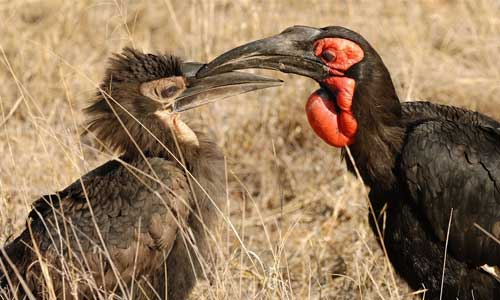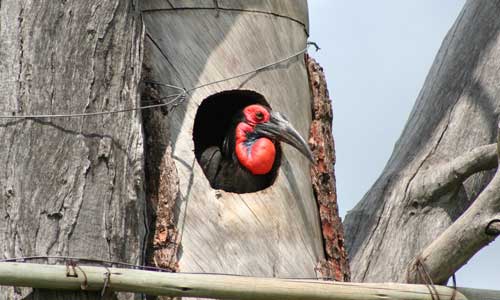Working to find ways to conserve the Southern Ground-Hornbill (Bucorvus leadbeateri)
By Lucy Kemp
This icon of the African savannas and grasslands is in swift decline and this is quantified in areas where populations are closely monitored, with the species now meeting the IUCN criteria for being regionally endangered for both South Africa (Taylor & Kemp, 2015) and Namibia (Simmons, Brown, & Kemper, 2015). The reasons for the decline are two-fold: numerous and expanding anthropogenic threats (Jordan, 2011) coupled with a biology and life history traits that make the species more vulnerable to extrication: being long-lived, slow- and cooperative breeding and carnivorous ( Kemp & Kemp, 1980; Kemp, 1995).
|
|
The myriad threats that the species faces include persecution for breaking windows due to their highly territorial nature. Each reflection is an ‘enemy’ and this leads to economic costs that many land-owners are unable to afford when they need to replace all of their windows. A growing electrical network throughout Africa is growing another threat – that of electrocution on transformer boxes and even collision with transmission lines. Farmers continue to indiscriminately use poison to eradicate perceived ‘pest’ species such a jackal, hyaena and leopard. The poisoned bait thus becomes available to scavenging species, including the ground-hornbills. Their group foraging behaviour also means that often entire groups are poisoned as they all feed off the same carcass (Kemp & Verdoorn, 2013). Lead toxicosis is a new threat discovered for the species – lead ammunition fragments remaining in offal left in the bush after a hunt, if consumed cause either outright death or subtle physiological and behavioural changes that lead to death in time (Koeppel & Kemp, 2015). Loss of habitat through wide-scale monoculture (timber and sugar cane) and land-use management leading to large-scale ecological change such as excessive use of fire or under- and overgrazing also impact habitat quality leading to exclusion of the species from the landscape. Loss of nest trees, a valuable commodity considering they need to provide hollows of at least 40 cm in diameter, through timber harvest, fire, violent storms with strong winds, floods or elephant damage reduce productivity as it may take the groups years to find a replacement within their territory or no breeding of no replacement is available (Kemp & Begg, 1996). Trade in live birds for personal collections and zoos is on the rise, compounding the long-term trade of body parts for traditional medicine and ritual (Bruyns, Williams, & Cunningham, 2013; Coetzee, Nell, & van Rensburg, 2014; Jordan, 2011; Whiting, Williams, & Hibbitts, 2011).
The species is culturally important throughout the range which leads to both conservation opportunity and challenges. In areas where cultural protection is strong as the species is revered or feared the species are able to coexist with rural communities, sharing the crop lands and cattle grazing areas, perhaps even thriving here as the grazing provides the wide open foraging areas the species prefers. However, in some areas the cultural protection is being eroded and birds are being hunted to supply traditional healers, with carcasses being found in city markets. In areas where there is no cultural association, the species is hunted for meat, leading to complete extirpation outside of protected areas.
Preliminary Population and Habitat Viability Analyses (Morrison et al., 2005; Spear, 2005) suggest that without conservation intervention the species will be lost. A number of conservation options were proposed and are currently being tested. Given the number of threats and low recruitment rates it is unlikely that any one action will reverse the decline but a multi-pronged, multi-disciplinary approach is being followed instead. A Single Species Recovery Plan was developed in 2011 (Jordan, 2011) that is being carried out by a number of partners and collaborators that form an action group that meet several times per year.
|
|
Threat mitigation is required to reduce the threats to the remaining wild populations and much of the initial focus is on awareness campaigns while methods of mitigations are sought. Many of the threats are too widespread for a single non-profit to be able to influence in any other way as we work with government to find solutions to poisonings and use of lead ammunition.
Electrocution: Insulation of transformer boxes has been shown to be effective but is expensive and an outlay that electrical entities are unlikely to pursue given the cost. Efforts to develop low-cost alternatives are underway.
Window-breaking: Using perforated vinyl film to coat windows is effective in removing the reflections that the species is responding to and allows for clear vision from within. This is cheaper and more attractive than using shade-cloth screens or paint. This film is being used extensively in rural schools and dwellings but we are yet to find an attractive version that will encourage upmarket lodges to cover their windows.
Education and awareness: Many of the threats can be minimized by simply empowering people with knowledge about the species, their interesting life history traits and the threats they face. Most people are unaware the species is threatened and with knowledge, are managing to change some behaviours – such as allowing poisoned bait balls to be available to non-target species. We target both areas where wild populations remain on both commercial farmland and rural communities and areas that are being primed for reintroduction, often where the species has been extirpated for over 50 years.
Artificial nests: The species takes readily to artificial nest boxes made of tree logs (Du Plessis, Erlich, Ross-Gillespie, & Rode, 2007; Wilson & Hockey, 2013) but these have a limited life span which reduces their efficacy in a national-scale recovery programme. Currently permanent materials are being investigated for use as an integral part of a national custodianship programme.
Reintroduction and captive breeding: The species never rears two chicks from a clutch and this provides the opportunity to harvest these redundant offspring for use in coordinated captive breeding and reintroduction programmes. The species is difficult to hand-rear but the last decade of trial and error has led to a successful protocol. Socialising the chicks to their species is paramount to their success when reintroduced back into the wild and this forms an integral part of the rearing. A specialised centre is being built to allow the best possible socialisation for these chicks, to grow a population of physically and psychologically health, strong founders.
Each conservation intervention in turn will help us slow and then reverse the decline of this magnificent ‘dinosaur’ of our savannas.
Learn more about ground hornbill conservation here.
References
Bruyns, R. K., Williams, V. L., & Cunningham, A. B. (2013). Finely Ground-Hornbill: The trade of Bucorvus cafer in a traditional medicine market in Bulawayo, Zimbabwe. In R. R. N. Alves & I. L. Rosa (Eds.), Animals in Traditional Folk Medicine (pp. 475–486). Berlin: Springer-Verlag Berlin Heidelberg. doi:10.1007/978-3-642-29026-8
Coetzee, H., Nell, W., & Rensburg, L. Van. (2014). An exploration of cultural beliefs and practices across the Southern Ground-Hornbill’s range in Africa. Journal of Ethnobiology and Ethnomedicine, 10 (1), 1–7. doi:10.1186/1746-4269-10-28
Du Plessis, M. A. D. U., Erlich, Y., Ross-Gillespie, A., & Rode, S. (2007). The use of artificial nest sites by Southern Ground Hornbills in a private conservation area of South Africa. In The Active Management of Hornbills and their Habitats For Conservation (p. 2005).
Jordan, M. (Ed). (2011). Final Southern Ground-Hornbill (Bucorvus leadbeateri) Species Recovery Plan for South Africa Species Recovery. Johannesburg.
Kemp, A. (1995). Bird Families of the World. In The Hornbills Bucerotiformes: Bird Families of the World (1st ed., pp. 94–99). Oxford: Oxford University Press.
Kemp, A. C., & Begg, K. S. (1996). Nest sites of the Southern Ground Hornbill Bucorvus leadbeateri in the Kruger National Park, South Africa, and conservation implications. Ostrich, 67, 9–14.
Kemp, A. C., & Kemp, M. I. (1980). The biology of the Southern Gound-Hornbill Bucorvus leadbeateri (Vigors) (Aves: Bucerotidae). Annals of the Transvaal Museum, 32 (February), 65–100.
Kemp, L., & Verdoorn, G. (2013). Poisons and ground-hornbills: a report on the extent of the threat and conservation actions required. Bela Bela.
Koeppel, K. N., & Kemp, L. V. (2015). Lead toxicosis in Southern Ground-Hornbills Bucorvus leadbeateri: a case from South Africa. Journal of Avian Medicine and Surgery.
Morrison, K., Daly, B., Burden, D., Engelbrecht, D., Jordan, M., Kemp, A., … Friedmann, Y. (2005). Southern Ground Horbill (Bucorvus leadbeateri) Population and Habitat Viability Assessment workshop report (Vol. 74). doi:10.1080/10807030500278610
Simmons, R. E., Brown, C. J., & Kemper, J. (2015). Southern Ground Hornbill. In Birds to Watch in Namibia: red, rare and endemic species. (pp. 38–39). Windhoek: Ministry of Environment and Tourism, Namibia Nature Foundation.
Spear, D. (2005). Dealing with socially complex species in population viability analysis: a case study ofthe cooperatively-breeding southern ground hornbill, Bucorvus leadbeateri. University of Cape Town.
Taylor, M. R., & Kemp, L. V. (n.d.). Southern Ground-Hornbill. In M. R. (ed). Taylor (Ed.), The Eskom Red Data Book of Birds of South Africa, Lesotho and Swaziland. Johannesburg: BirdLife South Africa.
Whiting, M. J., Williams, V. L., & Hibbitts, T. J. (2011). Animals traded for traditional medicine at the Faraday market in South Africa: species diversity and conservation implications. Journal of Zoology, 284 (2), 84–96. doi:10.1111/j.1469-7998.2010.00784.x
Wilson, G., & Hockey, P. A. R. (2013). Causes of variable reproductive performance by Southern Ground-hornbill Bucorvus leadbeateri and implications for management. Ibis, 155, 476–484.
Lucy Kemp is the project manager at the Mabula Ground Hornbill Project in South Africa.

